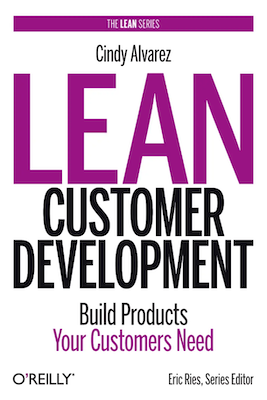Book review: Lean Customer Development
February 2022
Recommended: Yes
Why read it? It’s a thorough and intuitive guide to having productive, unbiased, and interesting research conversations, whether you’re developing a product or not.
Notes:
Customer development is a hypothesis-driven approach to understanding:
- Who your customers are
- What problems & needs they have
- How they currently behave
- Which solutions they’ll pay for
- How to provide the solution in a way that works with how they decide, procure, buy, and use
I’ve always thought of confirmation bias as being about seeking out supporting evidence and ignoring contradictory evidence, but “interpreting neutral or ambiguous evidence as supporting” is even worse, because most evidence is neutral or ambiguous.
Never thought of this.
What separates customer development from market research or user research is money. Customer development tells you whether somebody will buy your product.
Every invalidated customer development hypothesis represents time and money you didn’t waste building something nobody wanted.
A target customer profile is not about demographics, and it’s not a stock photo with an alliterative name like “Multitasking Meg.”
It’s best expressed as a matrix of positions along several spectra.
Do they value cash or time more highly? Control or convenience? Safety or risk?
“Where do I find potential customers to talk to?”
Well, where were you gonna find them after you built your product?
You can use your network, social networks, fora, ads, maybe accost people in cafes.
In all cases you have to seek out the people who acutely experience the pain you’re solving. Acutely enough that they’re happy to spend 20 minutes complaining about it.
These are not quote-unquote early adopters—that crowd is just into trying new tech, pain or no pain.
If you tap into people’s desire to help, and fix things, and sound smart, while addressing their concerns about time, commitment, and privacy, people will talk to you.
If you do all that and nobody wants to talk, your problem doesn’t exist or you’re asking the wrong folks.
Don’t pay people for customer development interviews.
If you can’t find people passionate enough about the problem you’re solving that they’re willing to chat, how will you find people passionate enough to pay money for your product?
Two terrifying risks to mitigate with customer development.
- You’ve failed to solve a problem the customer has
- You’ve failed to make the solution appealing enough
Basic customer development interview Q’s:
- Tell me about how you do {thing}
- Do you use any tools or tricks?
- If you could wave a magic wand and be able to do anything you can’t do today, what would it be?
- Last time you did {thing} what were you doing right before? What did you do right after?
- Any questions about {thing} that I should’ve asked, but didn’t?
Open ended followup questions:
- Can you tell me more about how that goes?
- Who’s involved in that decision?
- May I ask, why did you come to that conclusion?
- Last time you did {thing}, how long did it take?
We know the constraints we face in terms of culture, time, resources, but they’re the water we swim in so we tend not to talk about them.
We know what we’ve tried in the past that didn’t work, but we don’t necessarily remember (or enjoy reliving the failure).
Questions with no clear right or wrong answer are the best type of questions.
It’s essential to understand customers’ current behavior, because that’s your competition.
If the current behavior is “doing nothing” this is not your customer.
If the current behavior is “hacky solution that they kinda hate” you might be onto something.
Abstract one level up from the direct problem you think you’re solving, and ask about that.
Not “how do you monitor and limit your kids’ screen time?” but maybe “how does your family balance tech usage and overall health?”
(Still working on this one)
Constraints you might need to overcome.
- They don’t see the problem as a problem (this spreadsheet kinda sucks but it works for me …)
- They don’t know what’s possible technologically
- They’re operating in a stressful, or limiting physical environment
Some people have problems, know that they have them, but don’t want them solved.
“I’m not the kind of person who needs reminders.”
☝️ This person would rather miss some appointments than have their sense of autonomy and competence threatened.
They’re not your customer :)
Purchases are complicated, whether B2B or B2C.
In B2B you’ve got initiator, users, decision maker(s), buyer, influencers, gatekeepers.
In B2C you’ve got kids, spouse, social circle, landlord or HOA.
Pay attention when interviewees say “we” and be sure you know who “we” is in each context.
If you’re Facebook or Amazon, you have the traffic and resources to build and test ideas in production. You can get rapid and conclusive feedback.
If you’re not Facebook or Amazon, you should be doing customer development interviews.
By your 5th customer development interview, you should encounter at least one person who’s really excited about your idea.
After about 15-20 interviews, or when you stop hearing things that surprise you, it’s time to decide if you’re onto something with this problem + solution.
